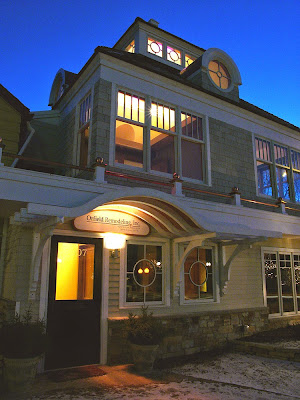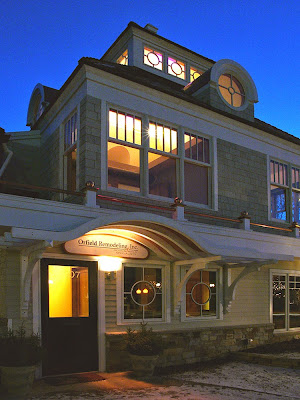It used to be the case that
view cameras were an essential part among the equipment of professional
photographers. They offer advantages
that other cameras simply don’t have. Digital
image manipulation software like Photoshop or Lightroom have enabled photographers
to compensate for the shortcomings of not using a view camera in post
production.
However, post production is
time consuming and not to the liking of everyone. Even though most image manipulation software
is relatively easy to do, it still has a considerable learning curve,
especially when it comes to more complicated operations like correcting for not
using a view camera.
View cameras are capable of a
variety of things that otherwise are difficult to overcome. For instance, they allow adjustments to
eliminate converging or diverging lines in a photograph. For instance, tall buildings will never be
correctly shown in a photograph taken with a conventional camera. The sides of the building will be converging
toward the top. The view camera
adjustments do allow correcting for that.




Converging lines View Camera corrected
Anyone who is interested in
close up work will quickly become aware that enough depth of field is hard to
come by. Sure, we can stop down our
lenses to increase depth of field, but that inevitably will cause shutter
speeds to be slowed down. While this is
not a problem with inanimate subjects, close up photography out doors will
quickly show how limited stopping down a lens can be, especially on windy days. Here too the adjustments of a view camera can
solve the problem easily,
Let’s take a closer
look. In order to photograph a tall
building, it is necessary to tilt the camera upwards. This the very reason for the converging
lines. The only time this will not be
the case is when the film or sensor plane is parallel to the subject. But that would cut off the top of the
building. Instead of tilting the camera,
a view camera will allow to keep the film plane parallel to the building and still
get the upward view by raising the lens.
To correct for lack of depth
of field is a little bit more complicated.
Let’s look at a simply product photograph. Since the film plane is not parallel to the
subject plane, the lens must be stopped down considerably to gain enough depth
of field. A view camera, on the other
hand, allows the application of the Scheimpflug principle. It is named after Austrian army Captain
Theodor Scheimpflug. He found that by
changing the position of the film or sensor plane (the focal plane) and that of
the lens, a large number of problems could easily be solved.


In this example, depth of
field is a definite problem. Using a
very small aperture is not necessarily the answer. We must remember that camera lenses do not
perform evenly at all apertures.
Especially stopping down beyond a certain f/stop will be accompanied by
a deterioration of the image. Applying
the Scheimpflug principle will allow to use the aperture range at which the
lens performs best. This entails to tilt
the lens, the focal plane or both in such a manner that the lens plane, the
subject plane and the focal plane all intersect at the same point. When that is the case, we will have virtually
unlimited depth of field, or so it appears.
Effectively what happens is that by using these movements, we actually
tilt the plane of focus to be the same as the subject plane.
Tilting the lens such that
its plane intersects with the intersection point of the subject
plane and the focal plane
will render seemingly unlimited depth of field.
In these two photograph by
Ansel Adams the same principle was applied to gain sufficient depth of field. As explained by Ansel Adams,
in the color photograph stopping down the lens was not an option because it would have caused
too slow a shutter speed to freeze the motion of the waves.
The same applies with close
up photography in nature. Here too all
we need to do is determine the subject place and adjust the lens and focal
plane accordingly. Stopping down the
lens will then gain enough depth of field for any subject matter that is not
within the subject plane.
Of course this brings up the
question of how this applies to Leica equipment. Any of the Leica SLR and full frame DSLR
cameras and any of the Leica M-series cameras with live view can easily be
converted to a small view camera with the Novoflex bellows BALPRO T/S or
CASTBAL T/S. Both will convert a camera
into a small view camera. Both offer
adapters for a large variety of cameras as well as lenses. In addition Novoflex offers a lens, specially
designed for use with the view camera movements. This is the SCHNEIDER KREUZNACH Apo DIGITAR
4,5/90mm. It is optimized for digital
cameras. The focusing range allows photography from infinity to 1.2x
magnification with 35mm or full frame cameras and up to 1.8x magnification with
APS-C cameras.
Novoflex Balpro T/S Novoflex Castbal T/S
Schneider Apo-Digitar 90mm
f/4.5
The lens is supplied with the
mounting adapters and a lens shade
The Schneider Balpro T/S in
action
For complete information of
the Balpro T/S and the Schneider Digitar go here
For complete information of
the Castbal T/S go here.
The capabilities of a view
camera go far beyond these few examples, but this article was not meant to be
an instruction manual for their use.
Instead it is just an instruction to show some of the capabilities of
these cameras, all of which allow photographs to be corrected prior to pressing
the shutter release and thus eliminating any time consuming post production
work. For myself, I rather take
photographs than sitting at a computer making up for problems that could easily
have been taken care of prior to shooting.
As far as full frame digital
cameras have progressed, many professional photographers look for even higher
performance levels to meet the needs of their clients. This inevitably means larger sensors with
higher resolution, medium format DSLR cameras.
Here too Leica has an answer with the Leica S system.
The purchase of Sinar by
Leica Camera AG has resulted in new, formerly unavailable possibilities for high-end
professional photography for Leica S medium format cameras.
The Sinar p MF-L was
developed especially for photographers who wish to usethe unique quality
characteristics of a Sinar view camera while using their Leica S high-end
medium format camera body. Exact control of perspective and selective
sharpness, the most important creative tools in photography, are set and
evaluated precisely on a view camera – all these advantages are now available
for Leica S users. In addition, this solution offers the benefit of a distinct
increase in quality by using high-resolution Sinaron lenses designed
specifically for digital imaging.
In combination with the Sinar
p system the Leica S users gain access to professional high-end photography. A
wide range of the accessories from the modular Sinar System can be used for the
professional work in the studio or outdoor applications. The Sinar p-MF-L
solution corresponds to the Sinar philosophy to provide modular systems that
always accommodate with the latest trends of the market.
This new adapter has the
following advantages:
>Exact control of
perspective, converging and diverging lines and selective focus
>Allows the use of the
high resolution Sinaron lenses
>Quick change from
horizontal to vertical image layout
All functions of the Leica S
can be controlled from a computer via software called CaptureFlow Leica.
The adapter is available for
1590 euros.
For more information go here
________________________________
To comment or to read comments please scroll past the ads below.
All ads present items of interest to Leica owners.
For more information on KOMARU and for orders go to: www.taos-photographic.com
For more information and pre orders go to: www.lenstab.com
To comment or to read comments please scroll past the ads below.
All ads present items of interest to Leica owners.
Inventive Camera Bags for All of Your Gear
For more information on KOMARU and for orders go to: www.taos-photographic.com
For more information and pre orders go to: www.lenstab.com
Next Friday - Cumberland: Island of Conflict and Change by Jeff Kauck

Click on image to enlarge
Order: info@gmpphoto.com
Click on image to enlarge
Order: info@gmpphoto.com
Click on image to enlarge
Order: info@gmpphoto.com

Click on image to enlarge
Order: info@gmpphoto.com
Please make payment via PayPal to GMP Photography
Click on image to enlarge
Order: info@gmpphoto.com
Please make payment via PayPal to GMP Photography
Click on image to enlarge
Order: info@gmpphoto.com
Please make payment via PayPal to GMP Photography











I like the Leica sinar connection. It gives Leica a whole new dimension. I wonder if there are any plans to allow the use of the M Leicas on this Sinar as well.
ReplyDeleteI have not seen any indication that this might be the case
DeleteIt would really perk my interest if M lenses could be used with a Leica M240 in this scenario!
ReplyDeleteI am not sure if there will be an M adapter from Novoflex for their bellows system. However, with their bellows adapted to a Leica Reflex camera, an R to M adapter might be a possibility. However, most full frame lenses, including the M lenses, have a relatively small image circle which put considerable restriction on their use with view camera movements. This is the very reason why they offer the Rodenstock 90mm Apo Digitar as an option. Of course most medium format camera lenses and certainly large format camera lenses would all work.
Deleteanother well done article!
ReplyDeleteThanks Bill, I appreciate it.
Delete